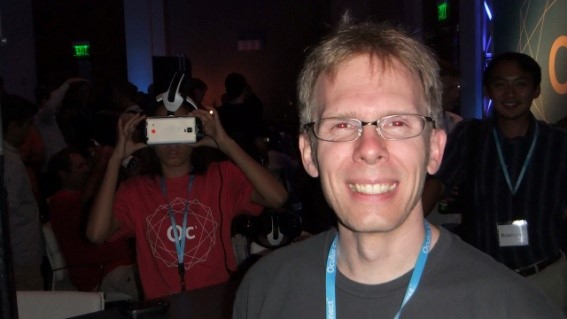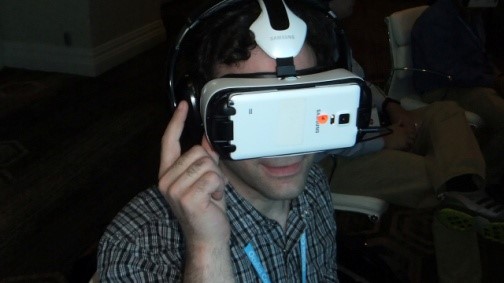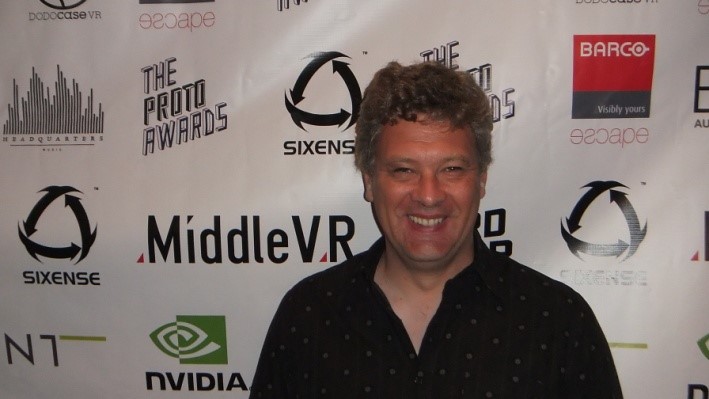Oculus Connect: The Future, And AMD Vs. NVIDIA
Oculus Connect was the first conference event for -- you guessed it -- Oculus VR. In addition to some eye-blowing demos, there was plenty to share and learn on and off the stage.
Grasping the Human Visual System

Dr. Richard Yao's session called The Human Visual System and the Rift was a pragmatic view of how our sensory systems create roadblocks that content makers are going to have to contend with. The biggest roadblock is the difference between what we see and the physical sensations that tell us whether we are moving or not. It's unclear if there is a real solution to this. Instead, there were a wide range of ideas including cockpit scenarios or creating visible cues to make it seem like our body and mind are both interpreting the content the same way.
What matters most is it's an evolving science with puzzles that are actively being solved.
John Carmack

John Carmack's keynote presentation primarily focused on Gear VR, Samsung's VR add-on for its Note 4 smartphone. Despite the majority of users being impressed with what Gear VR has to deliver, Carmack firmly believes there is still plenty of room for improvement -- especially when dealing with screen flicker and the lack of positional tracking.
The screen flicker is caused by mobile displays that can't refresh fast enough. This could be a long-term concern because it's unlikely that high refresh mobile panels will be readily implemented; VR is still a specialized market in Samsung's eyes. It's therefore necessary to experiment and discover new methods for getting the content to the screen to creatively overcome this hurdle.
One of the experiments they are looking at is interlacing. This is an old-school idea where the display is rendered in two passes: one wave is for the even scan lines, and the second wave is for the odd scan lines. This is done so fast that it should be imperceptible. This technique used to be very popular with CRT monitors to deliver higher resolutions on otherwise limited display technology. If Carmack's technique works, a 60 Hz panel could potentially deliver 120 Hz performance on a mobile display.

Positional tracking is going to be equally hard to implement, and experiments are ongoing. One of the ideas they are toying with is having a hybrid mechanism that features the smartphone's magnetometer, gyro, and camera to provide enough information to make positional tracking possible. This is all experimental and unproven, and it will take months of testing.
Get Tom's Hardware's best news and in-depth reviews, straight to your inbox.
When I bumped into John to catch up a little, he spotted my 3D camera and highlighted his excitement for 360 degree 3D image capture (the same class of movie capture done by the likes of Next VR, Jaunt, and Felix and Paul Studios. No wonder! Those Samsung Gear VR's are going to need something cool to look at -- and he highlighted this in his keynote as well.
Carmack wants to see a billion people with VR, and he was supportive of Google Cardboard because while it communicates the benefits of VR, it's well understood that premium options are available with better experiences because Cardboard is made of, well, cardboard.
Nvidia VR Support

Nvidia was making a big push for its new Maxwell class GTX980 GPUs. David Coombes is Nvidia's Developer Programs Manager, and he highlighted its special measures to dramatically reduce latency in VR applications with HMDs like the Oculus Rift.
According to Nvidia, its VR-optimized Maxwell GPUs can reduce latency by as much as 24ms compared to earlier GPU generations. This is a major deal when you figure that good VR experiences are aiming for 20ms or less of latency, and current Nvidia GPUs are part of a pipeline that is 57ms total.
More than this, David highlighted that the Nvidia 3D Vision drivers -- formerly limited to Nvidia 3D glasses -- are getting enhanced to have VR support with head tracking emulation. Nvidia recognizes that this isn't going to replace true native VR, but it has a strong gaming catalog to work from.
AMD VR Support
When Nvidia made its low-latency VR announcement, I immediately thought that the green team was going to have a de facto advantage over the red team. Fortunately for AMD users, this isn't the case.

According to Tom Forsyth, Oculus VR's Software Architect, this is a new enhancement for Nvidia GPUs that is already available in AMD graphics cards. In fact, some of these optimizations can be found in current Xbox One and Sony PlayStation 4 platforms as part of their respective SDK. Why? Because they are based on AMD GPUs.
In my opinion, the Nvidia reveal is a good news story for everyone. It's less about saying one GPU brand is better than another for VR; instead, this is about introducing a new choice and widening the landscape for GPU consumers interested in VR.
However, Forsyth stressed that while AMD's GPU hardware has the goods, things still have to happen on the software side to complete the optimization. In Forsyth's opinion, it's best for consumers to focus on benchmarks and measurable performance before making final choices on GPU favorites; each brand has its strengths and weaknesses.

Come back for more updates from Oculus Connect!
Neil Schneider is the Executive Director of The Immersive Technology Alliance. Non-profit and non-proprietary, the ITA is the official voice and standards body for immersive technologies like AR and VR. Mr. Schneider also runs Meant to be Seen which is credited as being the birthplace of The Oculus Rift and marks the spot where Palmer Luckey and John Carmack first met.
Follow us @tomshardware, on Facebook and on Google+
Seth Colaner previously served as News Director at Tom's Hardware. He covered technology news, focusing on keyboards, virtual reality, and wearables.
-
risc32 interlaced, old school, with a description of what it is?... damn, i guess i'm old.Reply
that and you guys should have me tag along for the photo headshots. I'm sure i could make these guys could look much better. holy cow! -
computerguy72 I bet the oculus will cause more video cards to get sold than anything going. Nvidia seems to have a more comprehensive VR slate of features. Unfortunate because I have a 290X.Reply -
cptnjarhead ReplyUnfortunate because I have a 290X.
Huh?
According to Tom Forsyth, Oculus VR's Software Architect, this is a new enhancement for Nvidia GPUs that is already available in AMD graphics cards. In fact, some of these optimizations can be found in current Xbox One and Sony PlayStation 4 platforms as part of their respective SDK. Why? Because they are based on AMD GPUs
-
rdc85 "....According to Tom Forsyth, Oculus VR's Software Architect, this is a new enhancement for Nvidia GPUs that is already available in AMD graphics cards. ...."Reply
mark the word "already"...
Looks like becoming sole console hw provider, have it's own merit..
